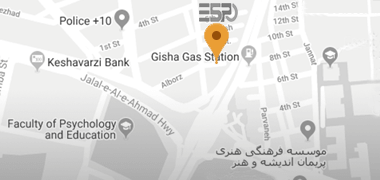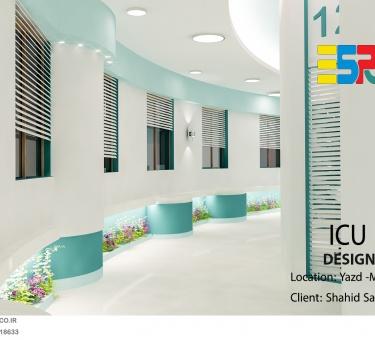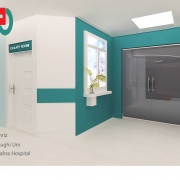بخش ICU (Intensive Care Unit) یا واحد مراقبتهای ویژه، بخشی از بیمارستان است که برای مراقبت و درمان بیماران با وضعیت بحرانی و جدی طراحی شده است. این بیماران نیاز به پایش مداوم و مراقبتهای تخصصی دارند. در این بخش، تجهیزات پیشرفتهای مانند دستگاههای تنفس مصنوعی، مانیتورهای پایش قلبی و دستگاههای حمایت از عملکرد اعضای حیاتی بدن موجود است. در ICU، تیم درمانی شامل پزشکان متخصص، پرستاران آموزشدیده، و سایر کارکنان پزشکی به صورت ۲۴ ساعته در حال ارائه مراقبتهای ویژه هستند تا از سلامت و پایش دقیق بیماران اطمینان حاصل کنند. بیمارانی که دچار مشکلات تنفسی، نارسایی قلبی، شوک، یا پس از جراحیهای سنگین و حوادث هستند، اغلب به ICU منتقل میشوند. هدف اصلی در این بخش، تثبیت وضعیت بیمار و فراهم کردن بهترین شرایط برای بازیابی و بهبود است.
طراحی بخش ICU باید به گونهای انجام شود که علاوه بر ایجاد محیطی مناسب برای مراقبت از بیماران بحرانی، بهرهوری کادر درمانی را بهبود بخشد و همچنین فضایی ایمن و آرام برای بیماران و همراهان آنها فراهم کند. در طراحی این بخش باید به موارد زیر توجه شود:
1. فضا و چیدمان اتاقها
• اتاقهای بیمار: هر بیمار باید در اتاقی مجزا یا تختهایی با فاصله مناسب قرار گیرد تا حریم خصوصی و کنترل عفونت بهتر رعایت شود. در برخی موارد از اتاقهای شیشهای استفاده میشود تا امکان پایش مداوم بیمار توسط کادر درمان فراهم باشد.
• فضای مشترک و رفت و آمد: طراحی باید به گونهای باشد که دسترسی به هر اتاق برای پزشکان و پرستاران سریع و آسان باشد. معمولاً بخش ICU به شکل حلقهای یا شعاعی طراحی میشود تا دید و دسترسی به بیماران بهینه شود.
2. تجهیزات پزشکی
• دسترسی به تجهیزات: در هر اتاق باید تجهیزات مورد نیاز مانند مانیتورهای پایش علائم حیاتی، دستگاههای تنفس مصنوعی و پمپهای تزریق دارو به راحتی در دسترس باشند.
• برق اضطراری و سیستمهای پشتیبان: تجهیزات پزشکی حساس نیاز به منابع برق پشتیبان دارند تا در مواقع قطع برق بتوانند بدون اختلال کار کنند.
3. کنترل عفونت
• تهویه هوا: سیستم تهویه مناسب با فیلترهای HEPA برای جلوگیری از انتقال عفونتها بسیار مهم است. این سیستم باید به گونهای طراحی شود که جریان هوا کنترل شده و از انتشار عوامل عفونی جلوگیری کند.
• مواد ضدعفونیکننده: باید ایستگاههای ضدعفونی دست در ورودی و خروجی هر اتاق قرار داشته باشد تا پرسنل و همراهان به راحتی دستهای خود را تمیز کنند.
4. محیط کار پرسنل
• ایستگاه پرستاری: معمولاً ایستگاه پرستاری در مرکز بخش ICU قرار میگیرد تا پرستاران بتوانند به راحتی بیماران را پایش کنند و به تجهیزات دسترسی داشته باشند.
• فضای استراحت: برای بهبود کارایی و کاهش خستگی، باید فضایی برای استراحت کادر درمانی فراهم شود که به بخش ICU نزدیک باشد.
5. تسهیلات رفاهی
• فضای ملاقات: باید فضایی برای ملاقات همراهان و بیماران وجود داشته باشد، اگرچه ملاقاتها در ICU محدود است. این فضا باید آرام و به دور از شلوغی باشد.
• نورپردازی و صدا: طراحی نور و کنترل صدا در بخش ICU اهمیت زیادی دارد. نور باید قابل تنظیم باشد و صداهای محیطی مثل بوق دستگاهها به حداقل برسد تا آرامش بیمار حفظ شود.
سیستمهای ارتباطی و فناوری
• مانیتورینگ مرکزی: سیستمهای پایش مرکزی باید در ایستگاه پرستاری نصب شود تا اطلاعات همه بیماران در یک مکان قابل دسترسی و مشاهده باشد.
• تجهیزات ارتباطی پیشرفته: امکان برقراری ارتباط سریع بین کادر درمانی و همچنین ارتباط با خانواده بیمار باید فراهم باشد. در نهایت، طراحی بخش ICU باید علاوه بر کارآمدی و ایمنی، به کاهش استرس و تسریع در روند بهبود بیماران کمک کند.
ارتباط فضایی بخش ICU باید چگونه باشد؟
ارتباط فضایی بخش ICU با سایر بخشهای بیمارستان از اهمیت بالایی برخوردار است، چرا که بیماران بستری در ICU در وضعیت بحرانی قرار دارند و نیاز به مراقبتهای ویژه و خدمات پزشکی فوری دارند. برای بهبود کارایی و افزایش سرعت در ارائه خدمات، طراحی فضایی باید به گونهای باشد که ارتباط سریع و مستقیم با بخشهای کلیدی بیمارستان فراهم شود.
۱. ارتباط با بخش اورژانس بخش ICU باید به بخش اورژانس نزدیک باشد تا در مواقع نیاز، بیمارانی که از اورژانس وارد بیمارستان میشوند و وضعیت بحرانی دارند، به سرعت به ICU منتقل شوند. این مسیر باید از لحاظ دسترسی، آسان و سریع باشد و امکان حمل بیماران با تخت یا برانکارد به راحتی فراهم شود.
۲. ارتباط با اتاق عمل ارتباط فضایی ICU با اتاق عمل از اهمیت زیادی برخوردار است، به ویژه برای بیمارانی که پس از عملهای جراحی سنگین نیاز به مراقبتهای ویژه دارند. مسیر مستقیم و کوتاه بین این دو بخش باعث کاهش زمان انتقال بیمار و بهبود نتایج درمانی میشود.
۳. ارتباط با بخشهای تصویربرداری بخشهای تصویربرداری مانند CT اسکن، MRI و رادیولوژی باید در نزدیکی ICU قرار داشته باشند، چرا که بیماران ICU ممکن است نیاز مکرر به انجام آزمایشات تصویربرداری برای تشخیص و پیگیری داشته باشند. طراحی این ارتباط باید به گونهای باشد که حمل و جابجایی بیماران به راحتی انجام گیرد.
۴. ارتباط با آزمایشگاه نتایج آزمایشات خون و سایر آزمایشات پزشکی برای بیماران ICU باید به سرعت و با دقت بالا آماده شود. به همین دلیل، وجود یک مسیر کوتاه یا حتی دسترسی مستقیم از ICU به آزمایشگاه، برای ارسال نمونهها و دریافت نتایج بسیار مهم است. همچنین سیستمهای اطلاعاتی دیجیتال میتوانند این روند را سرعت ببخشند.
۵. ارتباط با بخش استریل و تدارکات پزشکی بخش استریل و تدارکات پزشکی باید در نزدیکی ICU قرار داشته باشند تا تجهیزات و لوازم استریل به سرعت تأمین شود. همچنین امکان دسترسی فوری به تجهیزات حیاتی مانند دستگاههای تنفس مصنوعی یا داروهای اورژانسی باید فراهم باشد.
۶. ارتباط با بخشهای بستری (CCU و سایر بخشهای بستری) بخشهای مرتبط مانند CCU (بخش مراقبتهای ویژه قلبی) یا سایر بخشهای بستری نیز باید در نزدیکی ICU قرار داشته باشند تا در صورت نیاز بیماران بتوانند به سرعت از ICU به بخشهای مراقبت ویژه قلبی یا سایر بخشها منتقل شوند. این انتقال به خصوص در مواردی که بیماران وضعیت بهتری پیدا کرده و نیاز به مراقبت کمتری دارند، اهمیت دارد.
۷. ارتباط با بخش خدمات رفاهی و همراهان بیمار در طراحی بیمارستان، باید فضایی برای همراهان بیمار در نزدیکی ICU در نظر گرفته شود تا در مواقع اضطراری بتوانند سریعاً به اطلاعات و وضعیت بیمار دسترسی پیدا کنند. همچنین امکاناتی مانند سالنهای انتظار باید آرام و نزدیک به ICU باشد تا ارتباط مؤثر با کادر درمانی و پرستاران امکانپذیر باشد.
۸. ارتباط با بخش داروخانه بیمارستان ICU باید دسترسی آسانی به داروخانه بیمارستان داشته باشد، چرا که بیماران این بخش معمولاً نیاز به داروهای خاص و ترکیبات دارویی پیچیده دارند. ارتباط سریع و مستقیم با داروخانه به منظور تهیه و توزیع داروهای اورژانسی و ویژه ضروری است. نتیجهگیری: برای بهبود عملکرد و کارایی بخش ICU، طراحی فضایی آن باید با در نظر گرفتن ارتباطات سریع و مستقیم با بخشهای کلیدی بیمارستان صورت گیرد. این ارتباطات به تسریع در انتقال بیماران، افزایش بهرهوری پرسنل درمانی و در نهایت بهبود نتایج درمانی کمک میکند
ابعاد و اندازه مورد نیاز هر فضا در طراحی بخش ICU
طراحی بخش ICU نیاز به توجه دقیق به ابعاد و اندازههای استاندارد دارد تا علاوه بر فراهم کردن فضای کافی برای تجهیزات و مراقبت از بیماران، ایمنی و راحتی بیماران و کادر درمانی نیز تأمین شود. در ادامه به ابعاد و اندازههای استاندارد برای بخش ICU اشاره میشود:
1. فضای اختصاصی برای هر تخت بیمار
معمولاً برای هر تخت در ICU بین 20 تا 25 متر مربع فضا در نظر گرفته میشود. این فضا برای جایگذاری تجهیزات حیاتی، مانیتورهای پایش، دستگاههای تنفسی و فضایی برای حرکت آزادانه پرسنل مورد نیاز است. • فاصله بین تختها: فاصله بین هر تخت باید حداقل 2.4 متر باشد تا حریم خصوصی بیماران حفظ شود و پرسنل بتوانند به راحتی به هر بیمار دسترسی داشته باشند.
2. ارتفاع استاندارد سقف:
ارتفاع سقف در بخش ICU باید حداقل 2.7 تا 3 متر باشد. این ارتفاع برای نصب تجهیزات سقفی و تهویه مناسب، همچنین کاهش احساس فشار روانی برای بیماران و پرسنل ضروری است.
3. ابعاد اتاق ایزوله
اتاقهای ایزوله برای بیماران با بیماریهای عفونی: باید دارای ابعادی بین 25 تا 30 متر مربع باشد و از تجهیزات ویژه مانند سیستم تهویه فشار منفی برخوردار باشد تا از انتقال عفونت به سایر بخشها جلوگیری کند.
4. فضای پرستاری و تجهیزات مشترک
ایستگاه پرستاری باید مرکزی و در دسترس باشد و فضایی حدود 9 تا 15 متر مربع را شامل شود. این فضا باید امکان مشاهده تمامی بیماران و دسترسی سریع به تجهیزات پایش را فراهم کند. • اتاق تجهیزات پزشکی: فضایی حداقل 10 تا 15 متر مربع برای نگهداری تجهیزات و لوازم پزشکی ضروری باید در نزدیکی بخش ICU تعبیه شود.
5. مسیرهای دسترسی و راهروها
راهروهای اصلی بخش ICU باید حداقل 2.4 تا 3 متر عرض داشته باشند تا انتقال آسان تختهای بیمارستانی و تجهیزات صورت گیرد. • دسترسی به آسانسور: باید یک آسانسور اختصاصی یا سریع در نزدیکی ICU برای انتقال بیماران اورژانسی و تجهیزات به سایر بخشها وجود داشته باشد.
6. نور و تهویه
استفاده از پنجرهها و فراهم کردن نور طبیعی میتواند بهبود روانی بیماران را تسریع کند. هر اتاق باید حداقل یک پنجره با اندازه مناسب داشته باشد. • تهویه هوا: سیستم تهویه باید دارای استانداردهای مناسب برای کنترل دما و جلوگیری از انتشار عفونت باشد. هر اتاق بیمار باید سیستم تهویه مستقل داشته باشد تا کیفیت هوا بهینه باشد.
7. اتاقهای ملاقات و استراحت
در بیمارستانهای مدرن، معمولاً فضایی به اندازه 10 تا 15 متر مربع برای ملاقات کوتاهمدت خانواده با بیماران در نظر گرفته میشود. • فضای استراحت پرسنل: این فضا باید به اندازهای باشد که چندین نفر از پرسنل بتوانند به صورت همزمان از آن استفاده کنند، معمولاً بین 15 تا 20 متر مربع.
8. سرویس بهداشتی و امکانات رفاهی
برای هر بخش ICU باید سرویسهای بهداشتی مناسب (معمولاً حداقل 1 سرویس به ازای هر 6 تخت) با دسترسی آسان و امکانات برای بیماران و پرسنل فراهم باشد. نتیجهگیری: طراحی ICU با رعایت استانداردهای ابعاد و اندازهها نه تنها ایمنی و راحتی را برای بیماران فراهم میکند، بلکه کارایی بخش و کیفیت خدمات پرسنل را نیز افزایش میدهد. فضای کافی برای هر تخت، تجهیزات و حرکت آسان پرسنل در کنار رعایت استانداردهای بهداشتی و تهویه از اصول کلیدی در طراحی این بخش حیاتی بیمارستان است.





